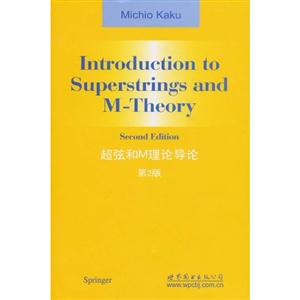超弦和M理论导论-第2版 内容简介
超弦和M理论是现代物理学中*有趣*活跃的研究课题之一。该问题比较困难同时也充满争议,一些人称之为“终极理论”,这是因为超弦理论有可能解决困扰人们多年的难题,即统一二十世纪*伟大的两个理论:广义相对论和量子场论。《超弦和M理论导论(第2版)》全面细致地讲解超弦理论和该领域的*新研究进展,内容包括四维超弦,Kac-Moody代数,Teichmuller空间和Calabi-Yau流形,M理论和D膜,对偶和BPS关系,矩阵模型等,可以作为研究生教材,同时对研究人员也有参考价值。作者首先简要介绍了点粒子理论,然后利用费曼路径积分详细讨论超弦理论。超弦研究需要很多数学工具,书中分别作了介绍,如指标定理,同调论和Kahler流形等。在第二版中,作者对内容做了整体修订,并添加了M理论的三个新章节。阅读《超弦和M理论导论(第2版)》需要量子力学和相对论的基本知识。读者对象:理论物理、高能物理、场论和弦论等专业的高年级本科生、研究生和相关专业的科研人员。
超弦和M理论导论-第2版 目录
Preface Acknowledgments Ⅰ First Quantization and Path Integrals 1 Path Integrals and Point Particles 1.1 Why Strings? 1.2 Historical Review of Gauge Theory 1.3 Path Integrals and Point Particles 1.4 Relativistic Point Particles 1.5 First and Second Quantization 1.6 Faddeev-Popov Quantization 1.7 Second Quantization 1.8 Harmonic Oscillators 1.9 Currents and Second Quantization 1.10 Summary References 2 Nambu-Goto Strings 2.1 Bosonic Strings 2.2 Gupta-Bleuler Quantization 2.3 Light Cone Quantization 2.4 BRST Quantization 2.5 Trees 2.6 From Path Integrals to Operators 2.7 Projective Invariance and Twists 2.8 Closed Strings 2.9 Ghost Elimination 2.100 Summary References 3 Superstrings 3.1 Supersymmetric Point Particles 3.2 Two-Dimensional Supersymmetry 3.3 Trees 3.4 Local Two-Dimensional Supersymmetry 3.5 Quantization 3.6 GSO Projection 3.7 Superstrings 3.8 Light Cone Quantization of the GS Action 3.9 Vertices and Trees 3.10 Summary References 4 Conformal Field Theory and Kac——Moody Algebras 4.1 Conformal Field Theory 4.2 Superconformal Field Theory 4.3 Spin Fields 4.4 Superconformal Ghosts 4.5 Fermion Vertex 4.6 Spinors and Trees 4.7 Kac-Moody Algebras 4.8 Supersymmetry 4.9 Summary References 5 Mulfiloops and Teichmuller Spaces 5.1 Unitarity 5.2 Single-Loop Amplitude 5.3 Harmonic Oscillators 5.4 Single-Loop Superstring Amplitudes 5.5 Closed Loops 5.6 Multiloop Amplitudes 5.7 Riemann Surfaces and Teichmiiller Spaces 5.8 Conformal Anomaly 5.9 Superstrings 5.10 Determinants and Singularities 5.11 Moduli Space and Grassmannians 5.12 Summary References Ⅱ Second Quantization and the Search for Geometry 6 Light Cone Field Theory 6.1 Why String Field Theory? 6.2 Deriving Point Particle Field Theory 6.3 Light Cone Field Theory 6.4 Interactions 6.5 Neumann Function Method 6.6 Equivalence of the Scattering Amplitudes 6.7 Four-String Interaction 6.8 Superstring Field Theory 6.9 Summary References 7 BRST Field Theory 7.1 Covariant String Field Theory 7.2 BRST Field Theory 7.3 Gauge Fixing 7.4 Interactions 7.5 Witten's String Field Theory 7.6 Proof of Equivalence 7.7 Closed Strings and Superstrings 7.8 Summary References Ⅲ Phenomenology and Model Building 8 Anomalies and the Atiyah-Singer Theorem 8.1 Beyond GUT Phenomenology 8.2 Anomalies and Feynman Diagrams 8.3 Anomalies in the Functional Formalism 8.4 Anomalies and Characteristic Classes 8.5 Dirac Index 8.6 Gravitational and Gauge Anomalies 8.7 Anomaly Cancellation in Strings 8.8 Summary References 9 Heterotic Strings and Compactification 9.1 Compactification 9.2 The Heterotic String 9.3 Spectrum 9.4 Covariant and Fermionic Formulations 9.5 Trees 9.6 Single-Loop Amplitude 9.7 Es and Kac——Moody Algebras 9.8 Lorentzian Lattices 9.9 Summary References 10 Calabi——Yau Spaces and Orbifolds 10.1 Calabi-Yau Spaces 10.2 Review of de Rahm Cohomology 10.3 Cohomology and Homology 10.4 K/ihler Manifolds 10.5 Embedding the Spin Connection 10.6 Fermion Generations 10.7 Wilson Lines 10.8 Orbifoids 10.9 Four-Dimensional Superstrings 10.10 Summary References Ⅳ M-Theory 11 M-Theory and Duality 11.1 Introduction 11.2 Duality in Physics 11.3 Why Five String Theories? 11.4 T-Duality 11.5 S-Duality 11.5.1 Type IIA Theory 11.5.2 Type IIB Theory 11.5.3 M-Theory and Type IIB Theory 11.5.4 E8 E8 Heterotic String 11.5.5 Type I Strings 11.6 Summary References 12 Compactifications and BPS States 12.1 BPS States 12.2 Supersymmetry and P-Branes 12.3 Compactification 12.4 Example: D = 6 12.4.1 D = 6, N = (2, 2) Theory 12.4.2 D = 6, N = (1, 1) Theories 12.4.3 M-Theory in D = 7 12.5 Example:D=4, N=2 and D=6, N=1 12.6 Symmetry Enhancement and Tensionless Strings 12.7 F-Theory 12.8 Example: D = 4 12.9 Summary References 13 Solitons, D-Branes, and Black Holes 13.1 Solitons 13.2 Supermembrane Actions 13.3 Five-Brahe Action 13.4 D-Branes 13.5 D-Brane Actions 13.6 M(atrix) Models and Membranes 13.7 Black Holes 13.8 Summary 13.9 Conclusion References Appendix A.1 A Brief Introduction to Group Theory A.2 A Brief Introduction to General Relativity A.3 A Brief Introduction to the Theory of Forms A.4 A Brief Introduction to Supersymmetry A.5 A Brief Introduction to Supergravity A.6 Notation References Index
展开全部
超弦和M理论导论-第2版 节选
《超弦和M理论导论(第2版)》内容简介:超弦和M理论是现代物理学中*有趣*活跃的研究课题之一。该问题比较困难同时也充满争议,一些人称之为“终极理论”,这是因为超弦理论有可能解决困扰人们多年的难题,即统一二十世纪*伟大的两个理论:广义相对论和量子场论。《超弦和M理论导论(第2版)》全面细致地讲解超弦理论和该领域的*新研究进展,内容包括四维超弦,Kac-Moody代数,Teichmuller空间和Calabi-Yau流形,M理论和D膜,对偶和BPS关系,矩阵模型等,可以作为研究生教材,同时对研究人员也有参考价值。作者首先简要介绍了点粒子理论,然后利用费曼路径积分详细讨论超弦理论。超弦研究需要很多数学工具,书中分别作了介绍,如指标定理,同调论和Kahler流形等。在第二版中,作者对内容做了整体修订,并添加了M理论的三个新章节。阅读《超弦和M理论导论(第2版)》需要量子力学和相对论的基本知识。读者对象:理论物理、高能物理、场论和弦论等专业的高年级本科生、研究生和相关专业的科研人员。
超弦和M理论导论-第2版 相关资料
插图:(1) Because we are dealing with a first quantized theory, we have to take the sum over all interacting topologies that are swept out by the string. For the Nambu——Goto string, the precise nature of these topologies is ambiguous and must be specified by hand. However, for the Polyakov form of the action, which contains an independent metric tensor, we can eliminate most of this ambiguity by specifying that we sum over all conformally and modular in equivalent configurations. (These terms will be defined later.) This will become a powerful constraint once we start to derive loops and will determine the function measure uniquely. The measure and the topologies in the Nambu-Goto action, however, are not well defined. (We must point out, however, that this rule of integrating over in equivalent surfaces does not automatically satisfy unitarity. This still must be checked by hand.)(2) The gauge fixing of weyl invariance for the Polyakov action, although trivial classically, poses problems when we make the transition to quantum mechanics. An anomaly appears when we carefully begin the quantization process. In fact, this conformal anomaly will disappear only in 26dimensions.




















